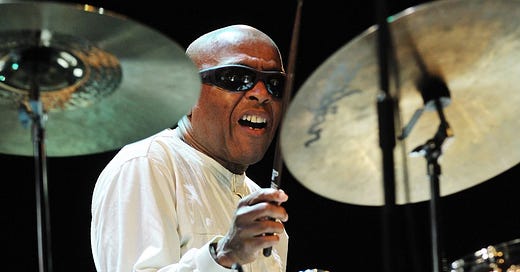As 2024 barrels toward its chaotic finale, the jazz world mourns yet again. Roy Haynes, the drummer’s drummer, left us yesterday at ninety-nine. Two days ago, Lou Donaldson followed at ninety-eight. In September, Benny Golson, the tenor titan, joined the celestial big band at ninety-five.
Here’s a bit of gallows humor before we get too heavy: A trumpet player dies and reaches heaven. Saint Peter grins and says, “You’re gonna love it here—the big band is unreal. Dizzy, Lee Morgan, Clifford Brown, Clark Terry—all the cats. But there’s one catch.” The trumpeter asks, “What’s that?” Saint Peter replies, “God’s girlfriend is a vocalist.”
With Golson’s passing, Sonny Rollins is now the last survivor of 1957’s iconic Great Day in Harlem photograph. Among the nonagenarian jazz legends still performing, only Sheila Jordan, 95, the scat-singing trailblazer, and Sun Ra’s cosmic maestro Marshall Allen, now 100, remain active. And Terry Gibbs, who just turned 100, as well, remains a presence on Facebook with his weekly livestream, sharing the stories of his life.
Sonny Rollins, 94, is still with us but hasn’t played in a decade. A respiratory illness, likely from breathing toxic air near the World Trade Center after 9/11, took his horn from him. Living just blocks from Ground Zero, Rollins faced a cruel irony: the resilience in his music met with an affliction tied to tragedy. Like asbestos exposure, the illness surfaced long after the damage was done.
Guitarist Kenny Burrell, 93, is also here, but inactive at this time.
In my twenties, ripping through 70s New York, I didn’t think much about the future. Respect for my elders? Sure. But imagining myself at their age never crossed my mind. Now, at 75, I’m grateful for where life has taken me. Surviving cancer and open-heart surgery, I feel lucky to still be here. With some good fortune, I might make it to my 90s. Aging, like jazz, is unpredictable—a delicate improvisation shaped by genetics, choices, and chance.
At 95, people vary widely in their conditions. Some, like Sheila and Marshall and Terry, remain marvels of vitality. Others face steep physical or mental challenges. Life’s end is either a slow fade or an abrupt final note, but it’s inevitable.
“Whether this is the first day of the Apocalypse
or the first day of the Golden Age, the work remains the same:
to love each other and ease as much suffering as possible.”
Spiritual Teacher, Ram Das
Our Jazz Masters have done just that, spreading beauty and understanding through their art.
Jazz reflects life: spontaneous, collaborative, and deeply personal. Born from the African American experience, it embodies resilience and the relentless pursuit of freedom. From the spirituals and blues of enslaved people to global stages, jazz is a testament to survival and reinvention. Its roots lie in pain, yet its voice is joy, hope, and defiance.
Jazz is about tension—the interplay between individuality and unity. A soloist soars, while the band holds the groove, creating harmony through contrast. It’s a pure metaphor for humanity’s best qualities. Its openness to influence, blending African rhythms, European harmonies, and American blues, allows jazz to evolve continuously, incorporating funk, rock, and Latin beats. It’s America’s greatest cultural gift, transcending borders and uniting people worldwide.
During the Cold War, jazz became a tool of diplomacy, with Louis Armstrong and Dizzy Gillespie spreading harmony across divided nations. Its emphasis on rhythm and improvisation makes it a universal language, resonating with listeners regardless of culture or tongue. Jazz, at its core, represents freedom—not just in its sound but as a symbol of risk, exploration, and the breaking of boundaries.
This is why jazz remains timeless. The music of Louis Armstrong, Duke Ellington, Charlie Parker, John Coltrane and their contemporaries doesn’t fade—it lives, guides, and inspires. Though the Jazz Masters are leaving us, their legacy endures, offering a philosophy, a history, and a call to our shared humanity. Their notes echo beyond time, reminding us that while life is fleeting, the art of expressing it is eternal.
I put together a Roy Haynes Memorial Video which includes Roy’s thoughts on meeting Sonny Rollins; they talk about their first session; Roy plays with Stan Getz and Gary Burton; Chick Corea and Miroslav Vitous, and an extended conversation with Nasar Abadey from the 2012 MidAtlantic Jazz Festival.






Beautifully said. Whenever I’m going to explain to folks what jazz is all about and why I love it, I will use your metaphore. Jazz is about freedom and cooperation. Originating from pain but celebrating life
Wow! One of the greats. It’s a happy feeling - that he lived and played so long. In the interview he says that he never studied or practiced rudiments - which I believe - but he could play them like crazy. Amazing videos thanks.